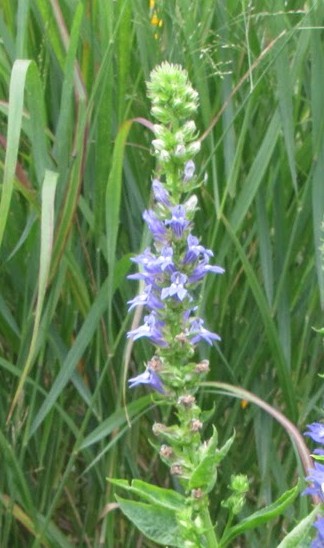 This clump-forming herbaceous perennial, also known as blue cardinal flower, is native to eastern United States where it grows in moist to wet places such as floodplains, bottomlands, along streams and ponds, drainage ditches, and marshes. It is erect, usually unbranched, and has medium to dark green leaves up to five inches long and two inches wide. The flowers are borne in terminal racemes on central stems in mid- to late summer. Each lilac-blue flower is tubular, one to one and a half inches long, and has two lips, the lower with three lobes, the upper with two. Small white blotches appear at the base of the lower lobes. Capsules with small seeds follow the flowers. The root system is a taproot that sometimes forms basal offsets. The pollen and nectar attracts bees, including humming bees, and sometimes hummingbirds and large butterflies. Blue lobelia is an excellent choice for the wettest and middle zones of a rain garden and is a fine addition to a woodland garden or around a pond where it will naturalize.
This clump-forming herbaceous perennial, also known as blue cardinal flower, is native to eastern United States where it grows in moist to wet places such as floodplains, bottomlands, along streams and ponds, drainage ditches, and marshes. It is erect, usually unbranched, and has medium to dark green leaves up to five inches long and two inches wide. The flowers are borne in terminal racemes on central stems in mid- to late summer. Each lilac-blue flower is tubular, one to one and a half inches long, and has two lips, the lower with three lobes, the upper with two. Small white blotches appear at the base of the lower lobes. Capsules with small seeds follow the flowers. The root system is a taproot that sometimes forms basal offsets. The pollen and nectar attracts bees, including humming bees, and sometimes hummingbirds and large butterflies. Blue lobelia is an excellent choice for the wettest and middle zones of a rain garden and is a fine addition to a woodland garden or around a pond where it will naturalize.
Type: Herbaceous perennial
Bloom: Light to medium lilac blue tubular, two-lipped flowers are borne in terminal racemes in mid- to late summer.
Size: 1-4′ H x 1-1.5′ W
Light: Part shade; full sun in cool climates and adequate water
Soil: Fertile, moist to wet; not drought tolerant
Care: Low maintenance
Hardiness: Zones 4-9
Pests and Diseases: None of significance; susceptible to smut, rust, leaf spots, and slugs
Propagation: Seed (moist stratification for two months at 40 degrees); division
Companion Plants: Boneset (Eupatorium perfoliatum), Blue vervain (Verbena hastata), Sneezeweed (Helenium autumnale), Swamp milkweed (Asclepias incarnata), swamp goldenrod (Solidago patula).
